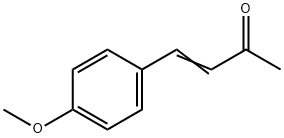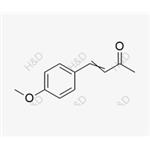Aroma
Slightly pungent, but in dilution sweet, floral and creamy odor of considerable tenacity.
1-(P-METHOXYPHENYL)-1-BUTEN-3-ONE, like many related ketones, has met with much resistance from perfumers and dermatologists. However, it has survived all attacks under the usual and probably reasonable argument, that in normal concentrations, it will have no harmful effects on the human
skin. Undoubtedly, perfumers are using scores
of materials with a much shorter history of
successful application.
It finds use in many floral perfume compositions, mainly Cassie bases, Acacia, Lilac,
Sweet Pea, Hyacinth, etc. In even lower concentration, it may give interesting effects in
Lavender, Fougeres, New Mown Hay (for which it was originally intended), etc.
Occurrence
Has apparently not been reported to occur in nature.
Uses
4-(4-methoxyphenyl)-3-buten-2-one is used in preparation of Thiazole derivatives as protein secretion inhibitors.
Preparation
From anisaldehyde and acetone by condensation using a suitable catalyst.
Metabolism
When the side chain of a mixed ketone contains a double bond, both the keto group and the double bond are potentially reducible in vivo. In a related material, methyl styryl ketone ( C
6 H
5 CH:CHCOCH
3 ) , the keto group appears to be more readily reduced than the double bond,with reduction via C
6 H
5 CH:CH.CH(OH)CH
3to the completely reduced carbinol compoundC
6 H
5[CH
2]
2CH(OH) CH
3, which is found as the main product (Fischer & Bielig, 1940). The ether link is relatively stable in substituted anisoles, such as anethole (p-CH
3OC
6H
4CH:CH CH
4), containinga potential carboxyl group attached to the aromatic ring (Williams, 1959).



